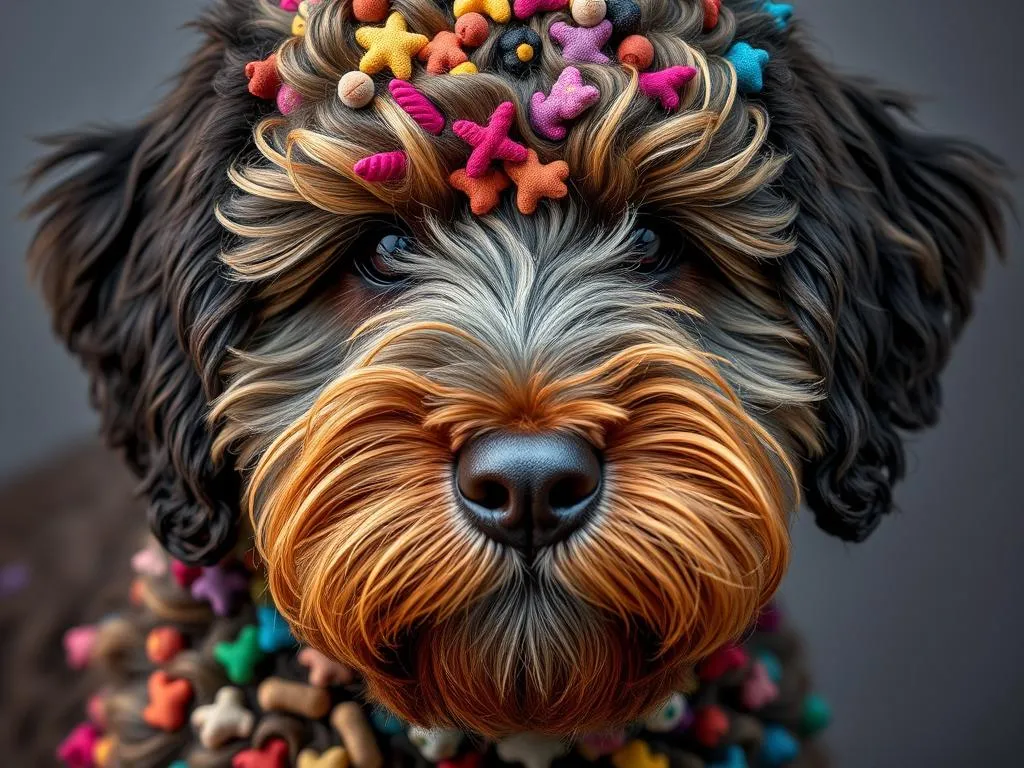
Labradoodles have gained immense popularity as a hybrid breed, celebrated for their friendly nature, intelligence, and hypoallergenic coats. As a mix between the Labrador Retriever and the Poodle, these dogs come in an array of labradoodle colors and patterns, making each one unique. Understanding the various colors and patterns not only enhances our appreciation for this breed but also helps potential owners make informed choices about their future furry friends.
Understanding the Labradoodle Breed
History of the Labradoodle
The Labradoodle was first developed in Australia in the late 1980s. The primary purpose behind this hybrid breed was to create a guide dog that would be suitable for individuals with allergies. By crossing the Labrador Retriever, known for its gentle temperament, with the Poodle, recognized for its intelligence and low-shedding coat, the result was a highly trainable dog that retained the desirable traits of both breeds. Over the years, selective breeding has further refined the Labradoodle, solidifying its place as a beloved family pet.
Characteristics of Labradoodles
Labradoodles are known for their striking looks and charming personalities. Physically, they typically exhibit a sturdy build with a broad head, expressive eyes, and a friendly demeanor. Their coat can vary significantly depending on their genetic makeup, ranging from loose curls to straight hair.
In terms of temperament, Labradoodles are generally social, loving, and eager to please. They are known to be great companions for families, singles, and seniors alike, making them a versatile choice for any household.
Labradoodle Color Variations
Solid Colors
Solid colors refer to coats that are uniform in hue without any variations. Common solid labradoodle colors include:
- Cream: A soft, light shade, often associated with a gentle demeanor.
- Chocolate: A rich, deep brown that gives Labradoodles a distinctive look.
- Black: A classic choice that stands out with its sleek appearance.
The genetics behind these colors is influenced by the parents’ breeds and the specific genes they carry. For example, the presence of eumelanin and pheomelanin genes dictates whether a Labradoodle will have a black, chocolate, or cream coat.
Parti Colors
Parti-colored Labradoodles feature a combination of two distinct colors, typically with one color dominating. For instance, a Labradoodle may have a white base coat with patches of chocolate or black. This striking contrast makes parti Labradoodles particularly appealing.
The genetics of parti coloring is controlled by a specific gene that allows for the distribution of colors in the coat. Common combinations include chocolate and white, black and white, or cream and white.
Phantom Colors
Phantom coloring is characterized by a two-tone effect where a base color is accented by a secondary color, often appearing in specific patterns. For example, a black Labradoodle may have tan markings on the eyebrows, cheeks, legs, and under the tail.
Genetic inheritance for phantom traits is more complex, as it requires the combination of genes from both parent breeds. This unique patterning adds to the charm and individuality of phantom Labradoodles.
Merle Patterns
Merle is a distinctive pattern that creates a mottled effect within the coat. This pattern can vary greatly, resulting in a unique look for each Labradoodle. Common color combinations for merle Labradoodles include blue merle, red merle, and chocolate merle.
However, it’s essential to note that merle coloring can be controversial due to potential health issues associated with this pattern, such as vision or hearing impairments. Responsible breeding practices are crucial when considering a merle Labradoodle.
Labradoodle Patterns
Brindle Patterns
Brindle is a unique pattern that features streaks of color, typically in a darker shade, over a lighter base. This creates a tiger-striped effect that can be quite striking.
Brindle Labradoodles may have a base coat of gold or light brown, with darker stripes running through. The genetics behind brindle patterns can be quite complex, involving multiple genes that dictate the distribution of color.
Ticking and Spotted Patterns
Ticking refers to small flecks or spots of color on a white or lighter base coat. This pattern is often seen in various breeds, including Labradoodles. For instance, a white Labradoodle may exhibit light brown spots, giving it a charming and unique appearance.
The genetics of ticking is still being studied, but it is believed to result from the interaction of several genes that influence the distribution of pigment.
Sable Patterns
Sable coloring is a beautiful blend where the tips of the hairs are darker than the base. A typical sable Labradoodle may exhibit a golden base with darker brown or black tips. This results in a rich, dimensional look that can be quite eye-catching.
Sable patterns often emerge from specific genetic combinations and can appear differently based on the individual dog’s coat type.
Factors Influencing Labradoodle Colors and Patterns
Genetics and Breeding
The labradoodle colors and patterns are primarily influenced by genetics. The combination of genes from both the Labrador Retriever and the Poodle plays a significant role in determining the final appearance of the coat. Additionally, certain traits can be passed down through generations, which is why it’s important for potential owners to work with reputable breeders who prioritize health and breed standards.
Influence of Coat Type
Labradoodles can have different coat types, primarily categorized into fleece and wool. Fleece coats are soft and wavy, while wool coats are denser and curlier. The coat type can influence how colors and patterns appear, with some colors more pronounced in one coat type than the other.
Regular grooming is essential to maintain the health and appearance of the coat, regardless of its type.
Choosing a Labradoodle Based on Color and Pattern
Personal Preferences
When selecting a Labradoodle, personal preferences regarding color and pattern are important. However, it’s essential to consider more than just aesthetics. A Labradoodle’s temperament, energy levels, and compatibility with your lifestyle should be prioritized over color choices.
For those who are particularly drawn to specific labradoodle colors and patterns, it can be helpful to visit breeders and interact with different puppies to see how their personalities align with your family’s needs.
Breed Standards and Expectations
Understanding the breed standards regarding colors and patterns can also guide prospective owners. The American Kennel Club (AKC) does not recognize Labradoodles as a pure breed, but many breed clubs have established guidelines for acceptable colors and patterns.
Working with reputable breeders who adhere to these standards can ensure that you are investing in a healthy puppy that is representative of the breed’s best traits.
Care and Maintenance of Different Colors and Patterns
Grooming Needs
Grooming requirements can vary based on the labradoodle colors and patterns. Regular brushing is crucial for all coat types to prevent matting and to keep the coat healthy. Additionally, Labradoodles may require professional grooming every few months, particularly those with wool coats.
Understanding the specific needs of your Labradoodle’s coat type will help you maintain its beautiful appearance while ensuring its comfort.
Health Considerations
Some colors and patterns may come with specific health considerations. For instance, merle Labradoodles can have a higher risk for certain health issues, including vision and hearing impairments. Regular veterinary check-ups and screenings are essential, regardless of color or pattern, to catch any potential health issues early.
In general, prioritizing health screenings and responsible breeding practices is vital for ensuring that your Labradoodle leads a happy, healthy life.
Conclusion
Understanding labradoodle colors and patterns enriches the experience of owning this delightful breed. From solid colors to unique patterns like merle and brindle, each Labradoodle is a work of art in its own right. As you consider adding a Labradoodle to your family, remember to prioritize temperament and health over aesthetics.
By focusing on these key aspects, you can ensure that your new furry friend will not only be visually stunning but also a loving companion for years to come.









